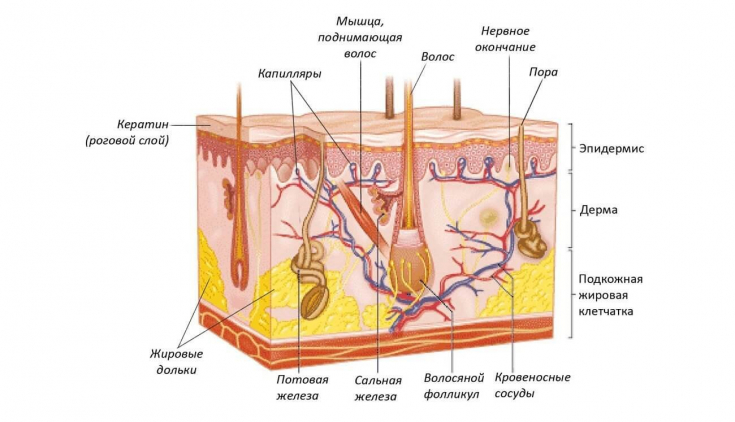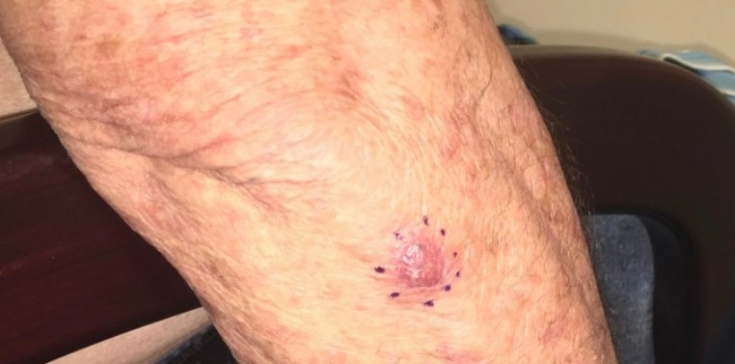The sebaceous gland is an integral structure of the skin, providing 90% lipids on its surface. Since much of the attention associated with the sebaceous gland comes from its central role in the development of acne, let's talk about its main physiology. The production of sebum is the most important function of the sebaceous glands. The squalene and fatty acids in the composition of sebium are unique. The production of sebum is critical for maintaining skin homeostasis and its physiological protection against environmental and infectious pathogens.
- Anatomy and histology of the sebaceous gland
- Physiology and functions of the sebaceous gland
- Sebaceous gland hyperplasia in clinical practice
Anatomy and histology of the sebaceous gland
The sebaceous glands are located in the mid dermis and almost always develop adjacent to the hair follicle, with the outlet draining into the follicular canal. This association is known as the pilosebaceous complex.
The exit point of the excretory duct of the sebaceous gland into the hair follicle is an important anatomical unit: between this point and the muscle that lifts the hair (musculus arrector pili) lies the zone of the hair follicle – source of local stem cells.
The sebaceous glands are largely identifiable by their "foamy"appearance under microscopy.

Cells look round and empty because the abundant lipid content is washed out during the staining process. Lipids can be visualized using Nile's lipophilic stain.
Read also: The ABC of the skin for a cosmetologist (Part 1): The structure of the epidermis
Relatively undifferentiated sebocytes are located along the outer layers of the gland, gradually becoming more differentiated and filled with lipid products towards the center. In the center, mature sebocytes undergo apoptosis, degrade and form a necrosis zone, eventually releasing their contents, together with which sebium is formed. This process of synthesis and release of lipids takes about a week in total complexity.
Physiology and functions of the sebaceous gland
The sebaceous gland secretes the vast majority of lipids to the skin's surface as sebium which helps to seal in moisture, preventing the skin from drying out.
In addition to cellular debris and lipids, sebum also contains antimicrobial agents, free fatty acids and matrix metalloproteinases.
These elements, combined with the formation of a lipid film, provide a protective barrier.
The sebaceous gland is also a target area for androgens. Androgens regulate sebaceous gland function by binding to nuclear androgen receptors (AR), stimulating cell proliferation and lipogenesis.
Read also: Acne: mechanisms of development and predisposing factors
The sebaceous gland can inactivate androgens through the presence of hydroxysteroid dehydrogenase. Type 1 isoform 5-alpha reductase, which serves to convert testosterone to its most potent form, is produced in large quantities in the sebaceous glands, especially the sebaceous glands on the face and skin heads.
Read also: Dermatological manifestations of hyperandrogenism
Corticotropin-releasing hormone (CRH) stimulates local skin cell receptors, resulting in an increase in pro-opiomelanocortin levels and a decrease in IL-8 synthesis in sebocytes, and also induces the production of cortisol. These effects together provide a powerful anti-inflammatory action that counteracts the normal cascade of stress signals and helps limit
The sebaceous gland often increases with the age of patients. To the inexperienced, sebaceous hyperplasia may appear similar to
basal cell carcinoma, leading to an unnecessary biopsy. However, the glands are still predisposed to the development of neoplasms. Muir-Torre syndrome, an autosomal dominant disorder characterized by the development of sebaceous adenoma.

The sebaceous gland is also associated with
androgenetic alopecia. Histological examination of the lesions demonstrates sebaceous hyperplasia on the affected area of the scalp, suggesting a role in the pathogenesis of alopecia.
Follow us on Facebook! Due to the activity of the sebaceous glands,
sebiumforms hydro-lipid mantle on the surface of the skin, protecting it both from external influences and reproduction of pathogenic microorganisms. A deep understanding of the anatomy, histology and physiology of these anatomical structures contributes to making the right decisions when choosing the tactics of treating such a dermatological disease as acne.
More interesting stuff on our





